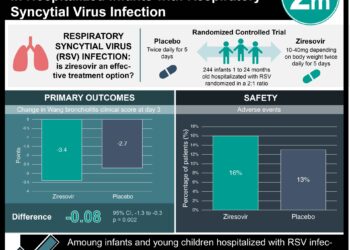On-demand inhalation treatment for bronchiolitis is superior to fixed schedule treatment
Image: PD
1. There was no significant difference in length of hospital stay or outcomes between children treated with racemic adrenalin and those treated with saline.
2. Regardless of the drug used, on-demand inhalation treatment resulted in shorter length of stay, less oxygen therapy, and fewer overall treatments.
Evidence Rating Level: 1 (Excellent)
Study Rundown: Bronchiolitis is a common pulmonary malady of infants most often caused by respiratory syncitial virus. Administering inhaled racemic adrenaline (RA) has become the standard of care of many providers. However, there is no guiding evidence addressing the frequency of delivery (on-demand versus scheduled) of the treatment. This study showed that regardless of the drug (RA or saline), on-demand inhalation treatment resulted in more favorable outcomes. The study included an interesting subgroup analysis showing that hospital stay was longer in younger than in older infants in the group receiving RA. This finding is contrary to those of prior studies that suggested RA is beneficial for bronchiolitis. Only one hospital in the study collected swabs for identification of the causative virus. It would be interesting to see the data stratified by virus type to determine if there was any virus-dependent treatment variation.
Click to read the study in NEJM
Relevant Reading: Pharmacologic Treatment of Bronchiolitis in infants
In-Depth [double blind randomized controlled trial]: This trial investigated the difference in clinical outcome between two drugs (inhaled racemic adrenaline (RA) and inhaled saline) and two frequencies of delivery (on demand or fixed schedule). A total of 321 children with signs of bronchiolitis completed the study and were randomized into four arms: RA on demand, RA fixed schedule, saline on demand, and saline fixed schedule. The primary outcome was length of hospital stay, while secondary outcomes included clinical change 30 minutes after first inhalation, use of oxygen and ventilatory support. There was no significant difference in length of hospital stay between children treated with RA and those with saline, nor were there differences in secondary outcomes. However, length of hospital stay was significantly shorter for children treated with on demand therapy, regardless of the drug (P=0.01).
By Akira Shishido, MD, and Mitalee Patil
More from this author: Peginesatide is noninferior to epoetin for anemia in hemodialysis patients [EMERALD Trials], Antibiotics improve outcomes in severe acute malnutrition, Carbapenem resistance in Enterobacteriaceae nearly quadrupled in the last decade, new study finds. Eculizumab treats atypical hemolytic-uremic syndrome, Prone positioning decreases mortality in severe ARDS (PROSEVA Trial), Peginesatide is noninferior to epoetin for anemia in hemodialysis patients [EMERALD Trials]
© 2013 2minutemedicine.com. All rights reserved. No works may be reproduced without written consent from 2minutemedicine.com. Disclaimer: We present factual information directly from peer reviewed medical journals. No post should be construed as medical advice and is not intended as such by the authors or by 2minutemedicine.com. PLEASE SEE A HEALTHCARE PROVIDER IN YOUR AREA IF YOU SEEK MEDICAL ADVICE OF ANY SORT. Content is produced in accordance with fair use copyrights solely and strictly for the purpose of teaching, news and criticism. No benefit, monetary or otherwise, is realized by any participants or the owner of this domain.







